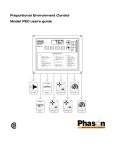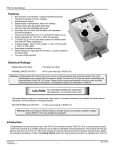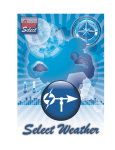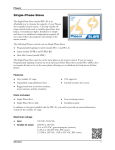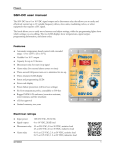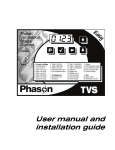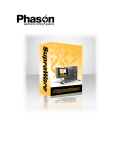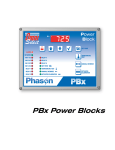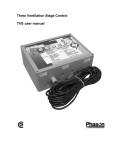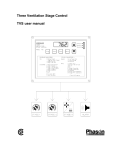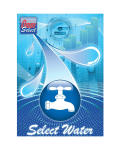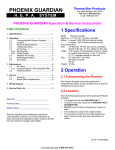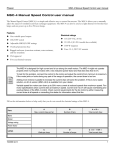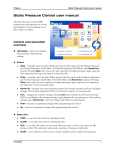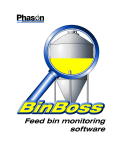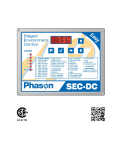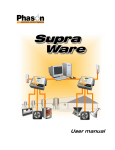Download Previous generation user manual
Transcript
PLUS Series Controls PEC+ SEC-HD+ The PLUS Control user interface PLUS Series controls feature a simple and convenient layout that allows you to check system status, change settings, and ensure only authorized personnel make changes. Table of contents Table of contents ...........................................................................................................................................i Getting started ..............................................................................................................................................1 The Status bar...............................................................................................................................................2 Making adjustments to the system ...............................................................................................................3 Stage mode ..................................................................................................................................................4 Variable speed mode....................................................................................................................................5 Variable speed operation ........................................................................................................................6 Actuator mode ..............................................................................................................................................7 Calibrating actuators...............................................................................................................................7 Configuring actuators .............................................................................................................................7 The growth curve concept ............................................................................................................................9 Setting the growth curve .......................................................................................................................10 Growth curve tips..................................................................................................................................10 Deactivating the growth curve...............................................................................................................11 System access............................................................................................................................................12 Security .................................................................................................................................................12 Master PINs ..........................................................................................................................................12 User PINs..............................................................................................................................................12 Units of measure...................................................................................................................................13 Control ID..............................................................................................................................................13 Special functions ........................................................................................................................................13 Restoring factory settings .....................................................................................................................13 Restoring the master PIN ......................................................................................................................13 Set-point ranges .........................................................................................................................................14 Installing the PLUS control ..........................................................................................................................15 Electrical ratings....................................................................................................................................15 Surge suppression................................................................................................................................15 Mounting Instructions ...........................................................................................................................16 PEC+ board layout...............................................................................................................................17 SEC-HD+ board layout ........................................................................................................................18 Wiring instructions.................................................................................................................................19 Connecting the variable speed stages..................................................................................................19 Connecting the variable speed stages..................................................................................................20 Three-phase wiring ...............................................................................................................................21 Connecting the relay stages .................................................................................................................22 Thermostat input for gas furnace or brooder ........................................................................................22 Connecting an actuator ........................................................................................................................23 Connecting an alarm system ................................................................................................................24 Connecting temperature sensors..........................................................................................................25 Extending the sensor .............................................................................................................................25 i Networking the control ................................................................................................................................26 Termination resistors.............................................................................................................................26 Wiring the network ................................................................................................................................27 Control messages.......................................................................................................................................28 Troubleshooting ..........................................................................................................................................28 Care and maintenance ...............................................................................................................................28 Maintenance .........................................................................................................................................28 Additional tips .............................................................................................................................................28 Setup worksheets .......................................................................................................................................28 Variable stage settings..........................................................................................................................28 Relay stage settings..............................................................................................................................28 Inlet actuator settings............................................................................................................................28 Growth curve setup...............................................................................................................................28 Service and technical assistance ................................................................................................................28 ii PLUS user manual Getting started Getting started Thank-you for purchasing a Phason PLUS control. This manual will help you get the most out of your PLUS control. Read the manual before installing and configuring your PLUS control. See Installing the PLUS control on page 15 for installation and wiring instructions. The equipment connected to the PLUS control must not draw more current than what the control stages are rated. Equipment that is rated higher than the control ratings will damage the control and void the warranty. Fill out the Variable speed settings, Relay stage settings, and Inlet actuator settings worksheets. Use these set-up sheets when making changes to the control’s set points. If you plan to use the growth curve, fill out the Growth curve setup sheet, and then program the growth curve settings before adjusting the individual stages. 170057 rev 13 1 The Status bar Phason The Status bar The Status Bar shows the present status of all stages of the PLUS Control. NOTE The PEC+ layout is shown. The SEC-HD+ has only three relay stages and one actuator stage. • The Alarm indicator lights up when an alarm condition exists. • The variable speed indicators, VS-1 and VS-2, light up when power is being supplied to variable speed fans 1 and 2. You may notice one of these indicator lights glowing fainter than the other, the fan represented by the fainter light, is running at less than full speed. • The stage indicators, ST-1 to ST-6 (ST-1 to ST-3 for the SEC-HD+), indicate which relays are ON or OFF. • The TEMP indicator lights up when the digital display is showing a temperature. • The TIME indicator lights up when the display is showing a time setting. Two digits to the right of the decimal will be shown when the value is less than 10.0 minutes and only one when the value is 10.0 minutes or greater. • The SPEED indicator lights up when the display is showing a speed value (0 to 100%). • The POS indicator lights up when the display is showing a position value (0 to 100%). • Pressing Max/Min displays the maximum ambient temperature in the room or zone over the previous 24 hours, press it again to display the minimum ambient temperature over the previous 24 hours. • The display “blinks” in this mode. This lets you know the displayed temperature is not the current temperature. If you press the button again, it will restore the current ambient temperature. If you forget, the control will display the current ambient temperature in a few seconds. 2 2005-04-13 PLUS user manual Making adjustments to the system Making adjustments to the system The OK button saves changes. The display shows Acc (accepted) when you press OK. If the display shows PIN, you must enter your PIN (personal identification number) before the settings will be accepted. The control will NOT save the changes until you press OK. The Mode button allows you to scroll through the programming modes. A green indicator lights up in the active panel (STAGE MODE, VSP MODE, ACT MODE, or G.C.MODE.) The Up button allows you to increase the value on the display. Holding the button will cause the settings to change at a faster rate The Down button allows you to decrease the value on the display. Holding the button will cause the settings to change at a faster rate. 170057 rev 13 3 Stage mode Phason Stage mode Use the Relay stage settings worksheet on page 28 to help configure your PLUS control. NOTE The PEC+ layout is shown. The SEC-HD+ has only three relay stages. You must press OK after each change to save the settings. The STAGE MODE indicator at the bottom right of the panel glows green when you are in stage mode. On the PEC+, the Stage 1 to 4 indicators light up if two inlet actuators are connected to the control. If only Stage 1 and 2 are illuminated, only one inlet actuator is connected. If no indicators are lit up in the left column, no inlet actuators are connected. On the SEC-HD+, the Stage 1 and 2 indicators light up if an inlet actuator is connected to the control. If no indicators are lit up, no inlet actuators are connected. The SEL button scrolls through the stages and the Alarm Hi/Lo. The indicators in the left column light up when you select the corresponding stage. If you scroll past your desired stage, keep scrolling through the stages by pressing SEL until you reach it. Heat or cool You must designate a relay stage as either heat or cool. To do this, press the H/C button. The HEAT indicator lights up when you assign the stage as ‘heat’. The COOL indicator lights up when you assign the stage as ‘cool’. You cannot assign a relay as a ‘heat’ or ‘cool’ stage if it has been assigned to an actuator. Duty cycle You can designate a relay stage as a duty cycle relay stage (after designating it as either heat or cool) by using the O/C Time (relay open/relay closed time) button to set an ON and OFF duration for the relay. The most common uses for this are misters and curtain machines. The ON time is the duration a relay is active. The ON indicator lights up when this mode is selected. The OFF time is the duration a relay is inactive. The OFF indicator lights up when this mode is selected. The duration is set in hundredths of a minute. See the example below. Toggle to ON to set the ON time for the relay. The digital display will show the current setting, use the Up or Down buttons to adjust the duration the relay will be closed (active). Toggle to OFF to set the OFF time for the relay. The digital display will show the current setting, use the Up or Down buttons to adjust the duration the relay will be open (inactive). Example: If you set the ON time to 100 and the OFF time to 500, the relay will be active for one minute, then inactive for five minutes. When the temperature rises above the set point for a cooling stage (falls below for a heating stage), the relay will be active for one minute, then inactive for five minutes. After the five minutes, the control does a check; if the temperature is still above the set point, the relay will be active again for one minute, then inactive for five minutes. 4 2005-04-13 PLUS user manual Variable speed mode Variable speed mode Use the Variable stage settings worksheet on page 28 to help configure your PLUS control. The VSP MODE indicator at the bottom right corner of the panel glows green when you are in variable speed mode. Press VSP Sel to select the variable stage. The VSP-1 or VSP-2 indicator lights up beside the active stage. Each time you press VSP Fn, a different function is selected. The indicator light glows red beside the active function. If you miss the function you want to adjust, or need to make changes to a function, press the VSP Fn button to scroll through the functions until the desired function is active. Repeat the steps below for each variable stage. Range Range is the temperature at which the fan hits full speed (maximum ventilation). When the Range indicator is lit, you can adjust the Range by pressing Up or Down. The Range cannot be below the temperature set point (Temp SP). Press OK to save the setting, and then press VSP Fn to move to the next function. Temp SP Temp SP is the desired or ‘target’ temperature for the room or zone. It is also the point at which the fan will start to increase from minimum idle to full speed. When the Temp SP indicator is lit, you can adjust the Temp SP by pressing Up or Down. This setting cannot be above the Range or below the idle off setting. Press OK to save the setting, and then press VSP Fn to move to the next function. Minimum idle Minimum idle is the speed the fan will operate at when the temperature is between the Idle off and Temp SP settings. It is a percentage of full speed. When the Min idle indicator is lit, you can adjust the Minimum idle speed by pressing Up or Down. Press OK to save the setting, and then press VSP Fn to move to the next function. Idle off Idle off is the temperature at which the fan turns off. When the Idle off indicator is lit, you can adjust the Idle off temperature by pressing Up or Down. This setting cannot be above the Temp SP. Press OK to save the setting, and then press VSP Fn to move to the next function. NOTE You must press OK after each change to save the settings. 170057 rev 13 5 Variable speed mode Phason Variable speed operation Function Temp SP Setting Range 80°F 86°F Idle off 75°F Min idle 20% of maximum ventilation Variable speed output The fan is at full speed. Range Fan speed increases as the temperature increases, or decreases as the temperature decreases. Temp SP The fan is at the minimum idle speed Idle off The fan is off. Fan speed Figure 1: Variable speed operation 6 2005-04-13 PLUS user manual Actuator mode Actuator mode Calibrating actuators Each time you place the jumper over the ACTUATOR PRESENT IN pins (see Figure 11 on page 23), the actuator will be calibrated. During calibration, the actuator opens, pauses, and then closes. The inlet should open completely then close completely if it is operating properly. If the calibration procedure stops after closing for the first time, or fails to position, the feedback signal is not connected correctly. Try reversing the positive and negative feedback wires. If this does not work, the potentiometer may be defective. Call your dealer for further assistance. To recalibrate an inlet, remove the actuator jumper, and then replace it on the ACTUATOR PRESENT IN pins. The actuator will recalibrate when you replace the jumper. You can position an inlet manually provided the inlet has calibrated correctly. By adjusting the minimum position setting, you can manually set the position of the inlet. The inlet will stay at this position until you change the setting. Follow these steps to position the inlet manually. 1. Set the minimum set point to the lowest possible temperature (32°F). 2. Set all the other set points to the maximum temperature (110°F). 3. Set all the open positions to 100%. Configuring actuators Use the Inlet actuator settings worksheet on page 28 to help configure your PLUS control. NOTE If you have not positioned the jumper on the circuit board to use an actuator (see Figure 11 on page 23) you cannot access this mode. The ACT MODE indicator at the bottom of the panel glows green when you are in this mode. PEC+ If you have configured the PEC+ to control two inlet actuators (by positioning the jumpers on the circuit board), you can select the actuator by pressing the ACT SEL button. The ACT1SEL indicator lights up when actuator 1 is selected, ACT2SEL when actuator 2 is selected. SEC-HD+ The SEC-HD+ can control one actuator and has no ACT SEL selector. If you have configured the SEC-HD+ to work with an actuator, it is automatically selected when you are in this mode 170057 rev 13 7 Actuator mode Phason Each time you press the ACT Fn button, a different function is selected. The indicator light glows red beside the active function. If you scroll past the function you want to adjust, press the ACT Fn button to scroll through the functions until you reach the desired function. Minimum Position Minimum Position is the percentage the actuator will be open when the temperature is at Minimum. When the Min Position indicator is lit, you can adjust the minimum position by pressing Up or Down. Select a position adequate to support minimum ventilation. Press OK to save the setting, and then press ACT Fn to move to the next function. Minimum Minimum is the temperature set point for the actuator. Below this point, the inlet is closed. When the Minimum indicator is lit, you can adjust the minimum temperature by pressing Up or Down. Press OK to save the setting, and then press ACT Fn to move to the next function. Follow the steps below for each stage. Stage Set Point Stage Set Point is the temperature set point for that stage of the actuator cycle. When the Stage 1 Set Pt indicator is lit, you can adjust the temperature set point for Stage 1 of the cycle by pressing the Up or Down buttons. Press the OK button to save the setting, and then press ACT Fn to move to the next function. Open Range Open Range consists of temperature and position settings. Open Range (temperature) is the temperature at which the actuator stops opening for the present stage. When the Open Range indicator and the TEMP indicator are lit, you can adjust the set point by pressing Up or Down. Press OK to save the setting, and then press ACT Fn to move to the next function. Open Range (position) is the percentage the actuator will be open when the temperature reaches the Open Range (temperature). When the Open Range indicator and the POS indicator are lit, you can adjust the position by pressing Up or Down. The actuator will open to this position proportionally as the temperature rises from the Stage Set Point to the Open Range (temperature). Press OK to save the setting, and then press ACT Fn to move to the next function. NOTE 8 You must press OK after each change to save the settings. 2005-04-13 PLUS user manual The growth curve concept The growth curve concept The growth curve allows you to select a period where the temperature set points in a zone or room are adjusted automatically. The growth curve set points are group set points. In other words, the individual set points for the variable and fixed stages will be adjusted without losing the relationship between these stages. This extremely powerful feature allows ventilation strategies to be put in place. Set points will change as they should, but the relationship between stages will remain consistent. You can use the growth curve to automatically change the set points for the stages in each step. Once you program the growth curve, the control makes the changes to the set points once every 24 hours. The PLUS control has an internal timer that counts 24-hour periods (days). The count begins when the control is first powered up. In the event of a power interruption, the day count will be retained, but the time elapsed in the current day will be reset to zero. You can reset the day count to zero by restoring the factory settings (see Restoring factory settings on page 13) The growth curve proportionally changes the current settings towards the next growth curve point over the duration for the current set point. During the seventh growth curve point, the set point remains constant. When the seventh growth curve point is complete, the growth curve restarts at step 1 with the step 1 settings. This is shown in the graph below. 170057 rev 13 9 The growth curve concept Phason Setting the growth curve The G.C. MODE indicator in the bottom right of the panel glows green when you are in this mode. The growth curve is not active when the control is shipped from the factory. The growth curve activates when the duration for step 1 is set to a value above zero. Follow the steps below to set up the growth curve: 1. Press Mode until the G.G. MODE indicator is lit. 2. Press GC Select to select the step you want to modify. One of the seven indicators will glow red to show which step you are modifying. 3. Press Up or Down to adjust the temperature for the step. The TEMP indicator in the status bar will be lit up and the digital display will show the setting. 4. Press Temp/Duration to change to the duration setting. Press Up or Down to adjust the duration for the step. The TIME indicator in the status bar will be lit and the display shows the setting. 5. Press OK to save the settings. The display will flash Acc to show the changes have been accepted. 6. Repeat the process for all seven steps of the growth curve. Press Mode when you have finished configuring the growth curve. You can verify the growth curve is active by watching the G.C. MODE indicator while displaying the ambient temperature. If the indicator flashes, the growth curve is enabled—if it is off, it is not enabled. Growth curve tips • Keep a record of the growth curve settings. See the Growth curve setup worksheet on page 35. • ALL seven temperature set points must be set, and all seven time intervals must be set to values greater than zero or the control will not operate properly. 10 2005-04-13 PLUS user manual The growth curve concept • You can make changes to all settings on the growth curve after it has been activated. If you make changes to a setting that has already passed in the growth curve cycle, the change will not take effect until the growth curve restarts. • You cannot set a new duration for an active step that is less than the time that has elapsed for that step. This will cause the growth curve to proceed to the next step. • Press GC Select while displaying the ambient temperature to observe the current step of the growth curve and the number of days until the next step. • When you set up the growth curve, set the step 1 temperature equal to the Temp SP for VSP-1. The Temp SP for VSP-1 is the target temperature. • Set the last duration for the last step for a longer period than you will need. This will allow you time for unexpected delays, cleaning, or other activities before the growth curve restarts its cycle. If the animals leave earlier than expected, you can always reset the growth curve at step 1. • When new animals enter the room, you may want to restart the growth curve at the beginning. Follow this procedure to restart the growth curve: 1. Press GC Select while the ambient temperature is displayed and then verify the seventh growth curve indicator is lit. 2. Press Mode until the G.C. MODE indicator lights up. 3. Press GC Select until the growth curve indicator lights up. 4. Press Temp/Duration and note the duration. 5. Press Down until the duration is 0 and then press OK. This causes the current growth curve step to complete. The growth curve will restart at step 1. 6. Press Mode until the G.C. MODE indicator lights up. 7. Press GC Select until the seventh indicator lights up. 8. Press Up and adjust the duration to the previous setting (procedure 4). 9. Press OK to save the setting. 10. To verify the growth curve has restarted, press Mode until the ambient temperature is displayed. The G.C. MODE indicator will flash indicating the growth curve is active. 11. Press GC Select to verify the current growth curve step and it’s duration. • If you change any of the non-growth curve temperature settings while the growth curve is active, when the growth curve restarts after step 7, the settings will not return to their original values. Deactivating the growth curve • Reset all durations to zero starting at step 7 and working to step 1 • Once the last duration is set to zero and Mode is pressed to exit the growth curve, the G.C. Mode indicator will shut off. This indicates the control is operating in conventional mode. Reset the control as indicated in the Stage Mode and Variable Speed Mode sections. 170057 rev 13 11 System access Phason System access The System Access buttons control several functions of the PLUS control. Security You can enter a PIN to prevent unwanted changes to the settings. The control has a master PIN and you can add additional user PIN numbers. The PIN must be a four-digit number consisting of the numbers one to four. The master PIN must be used to add or remove user PIN numbers, but you can use any valid PIN to change to the control's settings. You can disable the security PIN feature by setting the master PIN to 1111. This allows the settings to be modified without using a PIN. The master PIN is set to 1111 at the factory. If FAI is displayed after pressing OK (after a PIN number was entered), the PIN number was not entered correctly. NOTE: When the PIN numbers are being entered, they are not shown on the display. Master PINs To create a master PIN (when it is set to 1111): 1. Press 1, then OK. 2. Enter the new master PIN (must be four digits) and then press OK. To change the master PIN: 1. Press 1, then OK. 2. Enter the old master PIN and then press OK. 3. Enter the new master PIN and then press OK. User PINs To add a user PIN: 1. Press 2, then OK. 2. Enter the master PIN and then press OK. 3. Press 1, then OK. 4. Enter the new user PIN and then press OK. 12 2005-04-13 PLUS user manual Special functions To remove a user PIN: 1. Press 2 and then press OK. 2. Enter the master PIN and then press OK. 3. Press 2 and then press OK. 4. Enter the user PIN you want to remove and then press OK. Units of measure To change between Fahrenheit and Celsius temperatures, follow the steps below. 1. Press 4 and then OK. 2. Enter a security PIN (the master or any user PIN), and then press OK. 3. Press Up or Down to change the temperature readout and then press OK. Control ID The control ID is a four-digit number that identifies the control when it is networked with other controls. If you give each control a unique ID number, it makes supervising the controls easier. To set the control ID number, follow the steps below. 1. Press 3 and then press OK. 2. Enter the master PIN number and then press OK. 3. Enter the four-digit ID number and then press OK. Special functions You can perform two special functions: Restoring factory settings You can reload the factory settings by pressing Up and Down at the same time while powering up the control. The factory settings will replace all the current set points and disable the growth curve. Restoring the master PIN You can erase the user PIN numbers and restore the master PIN to 1111. To erase the user PIN numbers and restore the master PIN, follow the steps below. 1. Turn off the power to the control. 2. Press and hold the Up, Down, and 1 buttons while turning on the power to the control. You must hold the buttons until the ambient temperature displays (about five seconds). 170057 rev 13 13 Set-point ranges Phason Set-point ranges °F °C 32.0 to 110.0 0.0 to 43.3 Relay stages Temperature Set Point Relay stage ON/OFF time 0.00 to 30.0 minutes Relay stage mode COOL, HEAT, OFF Hi Alarm Lo Alarm Set Pt. to 110.0 Lo Alarm Set Pt. to 43.3 Lo Alarm 32.0 to Hi Alarm Set Pt. 0.0 to Hi Alarm Set Pt. 32.0 to Temp Set Pt. 0.0 to Temp Set Pt. Variable speed stages Idle off Min idle Temp Set Point Range 0 to 100 % Between Min idle and Range settings Temp Set Pt. to 110.0 Temp Set Pt. to 43.3 Actuator stages Position settings Temperature settings 0 to 100 % 32.0 to 110.0 0.0 to 43.3 32.0 to 110.0 0.0 to 43.3 Growth curve Temperature Set Points Duration 14 0 to 45 days 2005-04-13 PLUS user manual Installing the PLUS control Installing the PLUS control Only a qualified electrician should install the PLUS control. CAUTION: CAUTION: Turn off the power before installing or servicing the control. Install all equipment according to the applicable local electrical codes. Electrical ratings Variable stages 1/2: 10 FLA at 115/230 VAC Variable speed fan motors draw more current at reduced speeds than maximum speed. Fan motor specifications show current draw at maximum speed. Current over 10 amps will cause the control to overheat and eventually fail. Check the specifications of the motor by measuring the current at all speeds, or by consulting the dealer for information about the fan. CAUTION: For controlling shaded pole, permanent split capacitor, or universal motors only. Relay stages: 10 A at 115/230 VAC Alarm stage: 0.2 A at 230 VAC 0.4 A at 120 VAC 2.0 A at 30 VDC Fuses: 15 A, 250 VAC ceramic Surge suppression It is not possible to internally protect this product completely from the effects of power surges. We recommend that surge suppression devices be installed. Power surges can be the result of external influences (lightning, utility distribution problems), or they may be generated internally (by starting and stopping inductive loads such as feed mills). See your electrical contractor for specific recommendations. The user's lack of such precautions acknowledges their willingness to accept the risk of such loss or injury. 170057 rev 13 15 Installing the PLUS control Phason Mounting Instructions 1. Remove the four screws from the front cover and lift it off. 2. Unplug the ribbon cable to separate the bottom from the front cover. Turn the power off before disconnecting the ribbon cable from the base of the control. Failure to do this can seriously damage the control. 3. Use the large holes in each corner of the enclosure to mount the control on the wall with the four wood screws provided. 4. Use the knockouts at the bottom of the enclosure for mounting cable connectors. DO NOT make additional holes in the enclosure; this will void the warranty. Run all the wires through the knockout holes and connect all the grounds to the ground plate. Use caution when running the wires into the control. Do not drape or run wires across the electronic components on the circuit board, this can damage the components and affect the reliability of the control. NOTE Mount the enclosure with the knockouts facing the bottom. Failure to do this can allow moisture into the enclosure and damage the control. This will void the warranty. Mounting holes Electrical knockouts Ribbon cable Electrical knockouts 16 2005-04-13 Variable stage terminal blocks 170057 rev 13 Relay stage terminal blocks Incoming power terminal block Actuator terminal blocks Alarm system terminal block Temperature terminal blocks Voltage selection switch Ribbon cable connector PLUS user manual Installing the PLUS control PEC+ board layout Figure 2-A: PEC+ board layout 17 18 Variable stage terminal blocks Relay stage terminal blocks Incoming power terminal block Actuator terminal blocks Alarm system terminal block Temperature terminal blocks Voltage selection switch Ribbon cable connector Installing the PLUS control Phason SEC-HD+ board layout Figure 2-B: SEC-HD+ board layout 2005-04-13 PLUS user manual Installing the PLUS control Wiring instructions This section describes how to connect various loads to the PLUS control. 208 or 230 VAC 1. Connect the wires as shown in Figure 3 below. 2. Verify the correct voltage setting is selected on selector switch A before applying power to the control. NOTE: When connecting to 208 VAC, use the same lines and phase to power the variable speed stages. 115 VAC 1. Connect the wires as shown in Figure 4 below. 2. Verify the correct voltage setting is selected on selector switch A before applying power to the control. Incoming power terminal block L1 L2 Service panel Figure 3: 230 VAC connection Incoming power terminal block L1 NEUTRAL Service panel Figure 4: 115 VAC connection 170057 rev 13 19 Installing the PLUS control Phason Connecting the variable speed stages Maximum rating: 10 FLA at 115/230 VAC Fuse: 15 A, 250 VAC ceramic Connect the variable speed fan to the control as shown in Figure 5 below. Variable speed terminal block Incoming power L1 L2/ NEUTRAL Junction box Figure 5: Connecting a variable speed fan 20 2005-04-13 PLUS user manual Installing the PLUS control Three-phase wiring When you wire the PLUS control to a three-phase system, wire the control power and the variable speed stages to the same phase, as shown in Figure 6 below. DO NOT wire the PLUS control and the variable speed fans with different phases. If you wire the control and variable speed stages to different phases, the fans will operate erratically. Figure 7 shows an example of incorrect three-phase wiring. Incoming power terminal block Variable speed terminal block L1 L2 208 VAC L3 Figure 6: Correct three-phase wiring Incoming power terminal block Variable speed terminal block L1 L2 208 VAC L3 Figure 7: Incorrect three-phase wiring 170057 rev 13 21 Installing the PLUS control Phason Connecting the relay stages Fan or electric heater Connect the fan or heater to the control as shown in Figure 8 below. Maximum rating: 10 A at 115/230 VAC Relay stage terminal block Incoming power L1 Junction box L2/ NEUTRAL Figure 8: Connecting a fan or heater Thermostat input for gas furnace or brooder Connect the thermostat input to the control as shown in Figure 9 below. Maximum rating: 10 A at 115/230 VAC Relay stage terminal block Incoming power L1 L2/ NEUTRAL Thermostat inputs Gas furnace or brooder Figure 9: Connecting a thermostat input 22 2005-04-13 PLUS user manual Installing the PLUS control Connecting an actuator Maximum rating: 10 A at 115/230 VAC The linear actuator must have a feedback potentiometer. If the actuator does not have a built in potentiometer, you must connect an external one. 1. Connect the linear actuator to the control as shown in Figure 10 below. 2. Position the jumpers to select the actuators as shown in Figure 11 below. • If you are not using an actuator, set the jumper as shown in part A. • If you are using an actuator, set the jumper as shown in part B. PEC+/SEC-HD+ • Stage 1 opens Actuator 1 • Stage 2 closes Actuator 1 • ACT-1 FB is the feedback terminal block for Actuator 1 PEC+ only • Stage 3 opens Actuator 2 • Stage 4 closes Actuator 2 • ACT-2 FB is the feedback terminal block for Actuator 2. NOTE If you are using two actuators on a PEC+, select IN for both ACT1 and ACT2. If only ACT2 is selected, the control will assume an actuator is installed for ACT1, and relay stages 1 to 4 will be dedicated to controlling actuators. Actuator terminal block Relay stage terminal blocks Actuator power supply Motor Figure 10: Inlet actuator wiring 170057 rev 13 Figure 11: Actuator jumper position 23 Installing the PLUS control Phason Connecting an actuator (continued) In a typical installation, a linear actuator is connected to the inlets with a network of cables and pulleys. These inlets are generally small and are located in the ceiling or walls. They are usually spring loaded to help close the inlet. In other installations, larger inlets can be connected to the actuator directly or with a linking arm. A system operates with the most precision when using the largest amount of stroke that is feasible with the actuator. The actuator must have limit switches and a feedback potentiometer. Most linear actuators are available with internal adjustable limit switches and potentiometer feedback. A 10k Ohm, ten turn feedback potentiometer works best, but it can range between 1k and 20K Ohms. Phason suggests using Grainger part # 5A652, von Weise (Fasco) model # V00099BA76, or equivalent DC linear actuator which can be used with a DC power supply (Phason part # 124-0). You may require a bracket to prevent the actuator arm from rotating while it is extending. The DC power supply should have a snubber filter installed to protect the relay contacts from excessive electrical noise and transients. Connecting an alarm system Maximum ratings: 0.2 A at 230 VAC 0.4 A at 120 VAC 2.0 A at 30 VDC Connect a battery powered alarm system to the control as shown in Figure 12 below. The siren ratings must not be greater than the relay ratings. Connect an alarm panel or auto-dialler to the control as shown in Figure 13 below. Consult the alarm panel/auto-dialler user manual for installation instructions. Alarm system terminal block Alarm system terminal block Alarm disconnect switch Battery Alarm siren Figure 12: Connecting an alarm system 24 Battery charger Alarm panel or auto-dialer Figure 13: Connecting an alarm panel or auto-dialer 2005-04-13 PLUS user manual Installing the PLUS control Connecting temperature sensors The PLUS control can operate with one to four temperature sensors installed. The control detects when a sensor is installed and averages the temperatures before displaying it. A sensor can be installed in any of the four terminals. • Do not run the probe cable in the same conduit as AC power cables • Do not run the sensor cable beside AC power cables or near electrical equipment. • When crossing other cables or power lines, cross them at a 90 degree angle. Connect the temperature sensors to the control as shown in Figure 14 below. Temperature sensor terminal blocks Sensor wires Temperature probe Figure 14: Connecting a temperature sensor Extending the sensor • • You can extend temperature probe cables to lengths of up to 500 feet. Use two-wire 18 AWG jacketed cable. Phason recommends Belden # 9408, Alpha # 5052, or an equivalent. Extension cable is also available from Phason. For more information, contact your dealer or Phason. E C A F A 170057 rev 13 C D 25 Networking the control Phason A Slide three pieces of heat shrink tubing over the wires: one for the red wire, one for the black wire, and one for both. B Strip the ends of the wires and then twist them together. C Solder the wires together using rosin-core flux solder—DO NOT use acid core solder. D Slide the heat shrink tubing over the solder joints. E Shrink the tubing using a heat gun. F Your connection should look like this. Networking the control To connect your PLUS controls to a computer, you need to purchase the PLUSWARE software and install it on your computer. You also need to connect all your PLUS controls to each other and the computer. You can program each control with an identification number so it is easier to recognize the controls when using the computer. See Control ID on page 13 for programming instructions. Communication cable requirements: 100 Ω, CAT 3, two-pair, unshielded twisted-pair cable Termination resistors The last control on a communication channel must have the termination resistors or a termination module installed. If you have already removed the termination resistors from the last control, you can order a termination module (part number 210510) from your dealer. Remove the termination resistors on all the other controls by cutting the resistor leads with wire cutters. Only one end of each resistor needs to be cut to disconnect it from the circuit. The termination resistors are labelled R9 and R10. Ribbon cable connector Termination resistors Communication connector Display (cover) circuit board Figure 15: Termination resistors 26 2005-04-13 PLUS user manual Networking the control Wiring the network The computer must have a serial port to communicate with the PLUS control. The RS-485A Converter, which is available from your Phason dealer, is required to connect the computer to the PLUS controls. For information about wiring the network using the converter, see the RS-485A Converter installation guide. Connect the controls to the network as shown below. Connect all the PLUS controls to a single branch or line. NOTE Remove the termination resistors from all the controls except the last one on the channel (see Figure 15). Communication wiring Correct RS-485 Wire colour Incorrect First device All remaining devices A D D B C C C B B D A A Figure 16: Connecting a computer to multiple controls 170057 rev 13 27 Control messages Phason Control messages Message Description 1) The temperature probe is open. - - - 2) The temperature probe is shorted. 3) The control is resetting. 28 no 1 The 1 button has been pressed. You have entered the system access security function. no 2 The 2 button has been pressed. You have entered the system access security function. no 3 The 3 button has been pressed. You have entered the system access control ID function. no 4 The 4 button has been pressed. You have entered the system access Fahrenheit/Celsius function. PIn A system access function has been entered. The control is waiting for a PIN PAS The control has accepted a PIN FAI The control has rejected a PIN DiS The GC Select button has been pressed. The growth curve is disabled. EPF EEPROM failure has occurred. You must re-load the factory settings. EPS EEPROM saving error. The changes were not saved, you must make them again. ACC The current setting has been saved 2005-04-13 Phason Troubleshooting Troubleshooting Problem No power/display Variable speed 1/ variable speed 2 fans not running Variable speed 1/ variable speed 2 fan(s) run full speed 170057 rev 13 Cause Solution • circuit breaker at service panel is off • reset the circuit breaker • wiring incorrect • correct wiring • display board inter-connect cable is not plugged into the power supply board properly • plug in the display board cable • 115/230 VAC switch is in the wrong position • set switch to the correct setting • wiring incorrect • correct wiring • fuse(s) open • replace fuses • display board inter-connect cable is not plugged into the power supply board properly • be sure the inter-connect cable is firmly plugged in. • minimum idle setting(s) too low • increase minimum idle setting(s) • variable speed 1/ variable speed 2 idle off set to high • decrease idle off setting • temp set point above room temperature • adjust temp set point to desired temperature • power to fan(s) is off • change power to fan(s) to on • fan is faulty • replace fan • wiring incorrect • correct wiring • min idle speed to high • decrease min idle speed setting(s) • variable speed range matches temp set point • increase range setting • room temperature above temp set point • adjust temp set point to desired temperature 29 Troubleshooting Phason Troubleshooting (continued) Relay stages are not operating their loads • wiring incorrect • correct wiring • display board inter-connect cable is not plugged into the power supply board properly • be sure the inter-connect cable is firmly plugged in • turn-on setting(s) for stages incorrect • adjust turn-on setting(s) • STAGE SEL is set to cool for a heater • change to heat • STAGE SEL is set to heat for a fan • change to cool • power to load is off • check breaker for load • fan/ heater is faulty • replace fan/ heater Alarm relay not operating alarm system • wiring incorrect • correct wiring Display showing unusually high temperature • wiring incorrect • correct wiring • extending wire connections to temperature probe are providing a poor connection • re-solder temperature probe to extending wire • temperature probe damaged • replace temperature probe Display flashing 888 • the control is resetting • check line voltage Display Flashes EPF • the EEPROM has failed the checksum or non zero test • restore the factory settings Display Flashes EPS • five consecutive times data has failed during saving and the EEPROM and has failed • re-enter settings and save the changes Display shows ambient temperature jumping around • low voltage is being applied to the control • check line voltage to the control Variable speed 1/ variable speed 2 fan turns ON, runs at full speed, then turns OFF. Keeps cycling • hysteresis issue- outside temperature rising and falling quickly • Variable speed 1/ Variable speed 2 fan needs to have overlapping settings or higher range settings Heater stage cycles ON and OFF • heater is oversized for room • • set points are too close with variable speed fan and heater move temperature probe closer to heater, or widen set points Maximum temperature for the day is incorrect • the PLUS control’s 24 hour clock begins at the time the control is powered up, not at midnight • power up the control at the desired start time of the 24 hour clock, this will be the MIN/MAX reset time. 30 2005-04-13 Phason Care and maintenance Care and maintenance Moisture will not cause a problem with the control if you take proper care during installation. The control's enclosure is made of fire retardant plastic and sealed with a rubber gasket. The sensor entry is sealed with a liquid-tight cable connector. Use caution when washing the room with a high-pressure washer. DO NOT direct a high-pressure washer at the control. To clean the surface of the control, wipe it with a damp cloth. CAUTION: Turn off the power before cleaning or servicing the control. Maintenance • After the first two weeks of operation, remove the cover from the unit and check inside for moisture. Be sure to turn off the power to the control before opening the cover. • If there is moisture present, wipe it out with a dry cloth and check the cable entry points and rubber gasket for proper sealing. • If the cable connectors are not sealing, apply RTV or Silicon II sealant around the cable. Some silicone sealants release acetic acid while curing. This can cause corrosion and damage the control. Let the silicone cure completely (one to three days). Failure to do this may damage the control and void the warranty. • Check the control again after two weeks to verify it is sealing properly. • Open and inspect the control for moisture once a year. Proper care and maintenance will extend the life of the control. Additional tips • A field test board (part number 170042) is available that enables you to quickly test your PLUS series control to ensure it is wired correctly. The test procedure verifies the variable speed and relay stages are operating properly by testing each stage in order. • The field test board plugs easily in place and allows you to move through the tests by pressing the button on the board. After you have completed the testing, simply remove the test board and fasten the cover back on the control. You do not have to turn the power off while installing or removing the test board. • If you are using a single speed fan and want to take advantage of the variable speed 1 and 2 stages, set the variable speed minimum idle to 100%. This allows you to use the variable speed 1 and 2 stages like regular relays, with the set point being the idle off parameter. 170057 rev 13 31 Setup worksheets Phason Setup worksheets Fill out the following worksheets to help you configure and maintain your PLUS control. See Set-point ranges on page 14 for ranges. Variable stage settings Fill in your settings for the variable speed stages. Variable stage Location Idle off (°F/C) Temp SP (°F/C) Min idle (%) Range (°F/C) Stage 1 Fan 70°F 75°F 20% 85°F VSP-1 VSP-2 Example In the above example, the fan turns on at 70°F and runs for three seconds at full speed (to prevent icing), then idles at 20% until the temperature reaches 75°F. When the temperature is between 75°F and 85°F, fan speed increases proportionally from 20% to 100%. The fan reaches full speed at 85°F. Relay stage settings Put a check mark in the column beside each stage to note its use. Remember that the SEC-HD+ has three stages, not six. Actuator 2 Close Close Actuator 2 Open Open Actuator 1 Close Duty Cycle Actuator 1 Open Cool Relay stage Heat Configure relay as: Stage 1 Stage 2 Stage 3 Stage 4 Stage 5 Stage 6 Alarm stage High TEMPERATURE Alarm (°F/°C) Low temperature alarm (°F/°C) Alarm NOTE: 32 An actuator requires one relay stage for opening and a second relay stage for closing. 2005-04-13 Phason Setup worksheets Inlet actuator settings Use the worksheet below to help you configure your actuator(s). The description describes the process as the temperature rises. The reverse will happen when the temperature falls. Setting ACT-1 ACT-2 Description The actuator will be closed when the temperature is below this setting Minimum (°C/°F) The percentage the actuator is open when the temperature reaches the Minimum. Minimum position (%) Stage 1 Set point (°C/°F) The temperature at which the actuator starts opening for Stage 1 Open range temperature (°C/°F) The temperature at which the actuator stops opening for Stage 1 The percentage the actuator is open when the temperature reaches the Stage 1 open range Open range position (%) Stage 2 Set point (°C/°F) The temperature at which the actuator starts opening for Stage 2 Open range temperature (°C/°F) The temperature at which the actuator stops opening for Stage 2 The percentage the actuator is open when the temperature reaches the Stage 2 open range Open range position (%) Stage 3 Set point (°C/°F) The temperature at which the actuator starts opening for Stage 3 Open range temperature (°C/°F) The temperature at which the actuator stops opening for Stage 3 The percentage the actuator is open when the temperature reaches the Stage 3 open range Open range position (%) Stage 4 Set point (°C/°F) The temperature at which the actuator starts opening for Stage 4 Open range temperature (°C/°F) The temperature at which the actuator stops opening for Stage 4 Open range position (%) 170057 rev 13 The percentage the actuator is open when the temperature reaches the Stage 4 open range 33 Setup worksheets 34 Phason 2005-04-13 Phason Setup worksheets Growth curve setup Enter your growth curve settings in the chart below. Use all seven set points and durations to make restarting the growth curve easier. Set point Temperature (°F/°C) Duration (days) 1 2 3 4 5 6 7 170057 rev 13 35 Service and technical assistance Phason Phason controls are designed and manufactured to provide reliable performance, but they are not guaranteed to be 100% free of defects. Even reliable products may experience occasional failures and the user should recognize this possibility. If Phason products are used in a life support ventilation system where failure could result in loss or injury, the user should provide adequate back-up ventilation, supplementary natural ventilation, or an independent failure alarm system. The user's lack of such precautions acknowledges their willingness to accept the risk of such loss or injury. LIMITED WARRANTY This warranty applies only to this product, the PEC+/SEC-HD+, which is hereafter referred to as ‘the product’. If you need warranty service, return the product and original proof of purchase to your dealer. Phason Inc. (Phason) warrants the product subject to the following terms and conditions. This warranty is valid only to the original purchaser of the product, for two years from the manufacturing date. The manufacturing date is stated in the first eight digits of the serial number in the form year-month-day. Phason hereby warrants that should the product fail because of improper workmanship, Phason will repair the unit, effecting all necessary parts replacements without charge for either parts or labor. Conditions • Installation must be done according to our enclosed installation instructions. • The product must not have been previously altered, modified, or repaired by anyone other than Phason. • The product must not have been involved in an accident, misused, abused, or operated or installed contrary to the instructions in our user and/or installation manuals. Phason's opinion about these items is final. • The person requesting warranty service must be the original purchaser of the unit, and provide proof of purchase upon request. • All transportation charges for the product submitted for warranty must be paid by the purchaser. Except to the extent prohibited by applicable law, no other warranties, whether expressed or implied, including warranties of merchantability and fitness for a particular purpose, shall apply to the product. Any implied warranties are excluded. Phason is not liable for consequential damages caused by the product. Phason does not assume or authorize any representatives, or other people, to assume any obligations or liabilities, other than those specifically stated in this warranty. Phason reserves the right to improve or alter the PEC+/SEC-HD+ without notice. Service and technical assistance Your dealer will be happy to answer all technical questions that will improve your use of the control. Have your model number, serial number, and necessary information ready before you call your dealer. If your control requires service after the warranty period has expired, return the unit to your dealer. Phason Inc. 2 Terracon Place Winnipeg, Manitoba, Canada R2J 4G7 36 Phone: 204-233-1400 Fax: 204-233-3252 E-mail: [email protected] Web site: www.phason.ca 2005-04-13








































